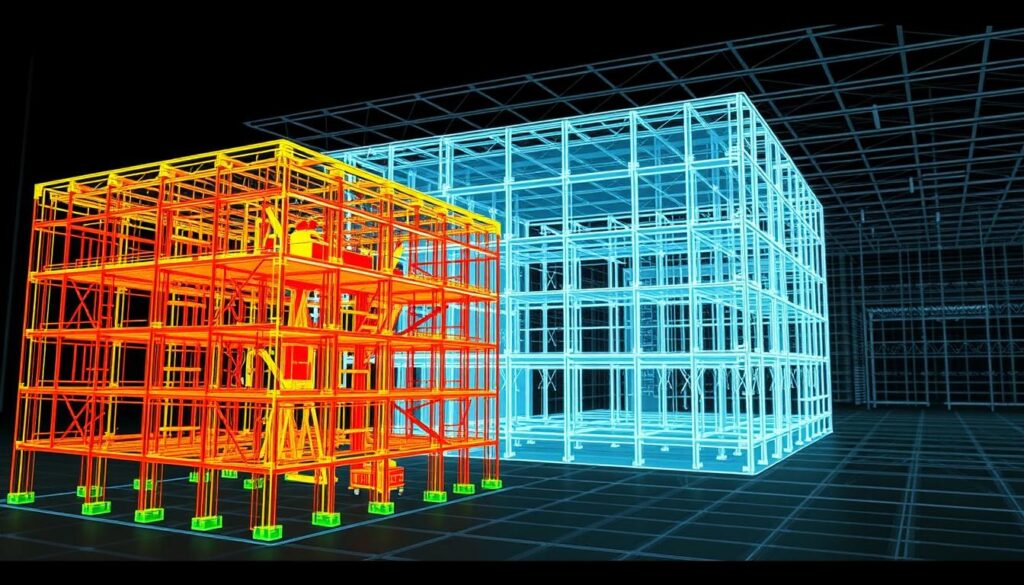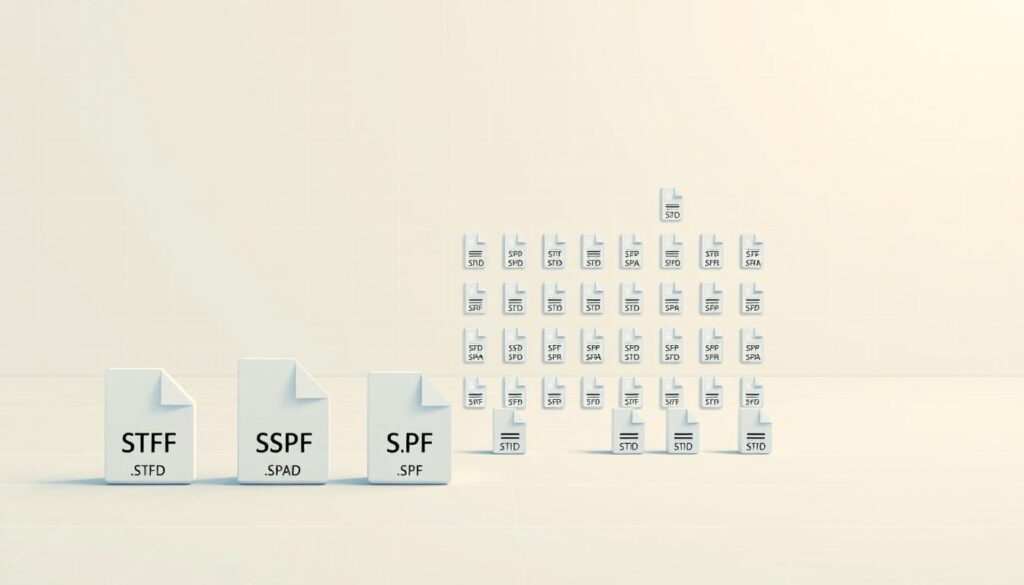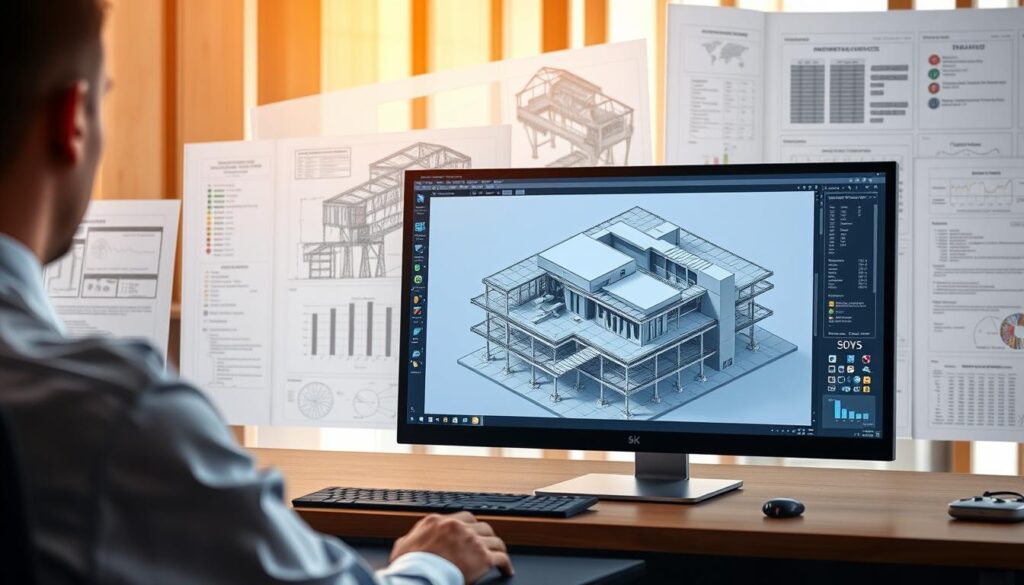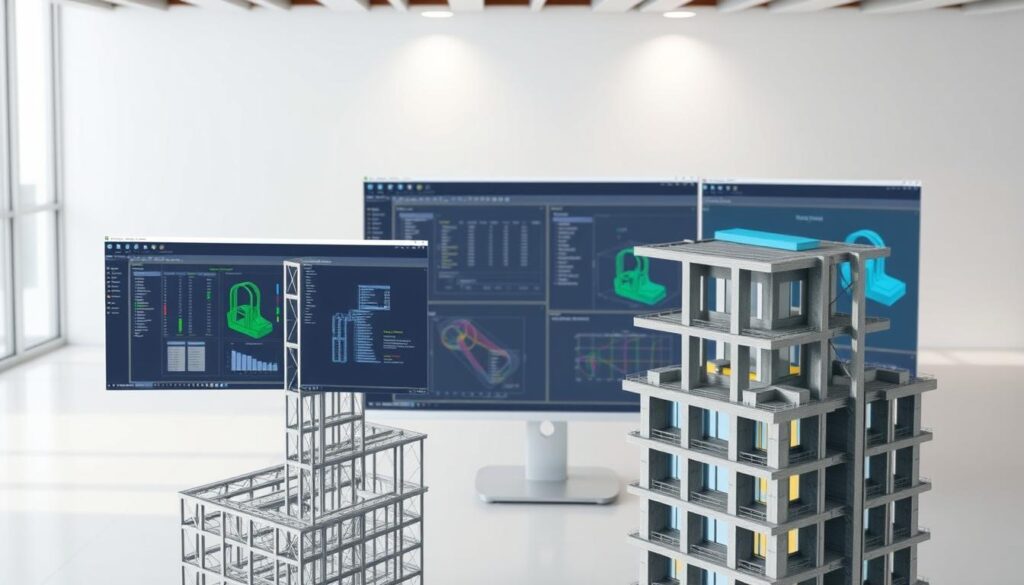Did you know that structural analysis and design are critical components of the construction industry, with a vast array of software applications available to facilitate these processes? Among these, STAAD Pro stands out for its advanced analysis capabilities and user-friendly interface, making it a preferred choice for many engineers.
Unlocking the full potential of STAAD Pro requires a comprehensive understanding of its features and functionalities. Whether you’re a beginner looking to get started or an experienced engineer seeking to enhance your skills, STAAD Pro tutorials can provide the necessary guidance.
Key Takeaways
- Learn the basics of STAAD Pro and its application in structural analysis and design.
- Discover advanced techniques for modeling and analysis.
- Understand how to optimize your designs using STAAD Pro’s advanced features.
- Gain insights into best practices for structural design and analysis.
- Enhance your skills with practical, hands-on experience through tutorials.
Introduction to STAAD Pro
STAAD Pro is a powerful tool for structural analysis and design, developed by Bentley Systems. It has become a cornerstone in the field of structural engineering due to its advanced capabilities and compliance with international design codes.
What is STAAD Pro?
STAAD Pro is a comprehensive software solution used for the analysis and design of structures. It supports various materials, including steel, concrete, and timber, making it versatile for different construction projects. The software is designed to help structural engineers create efficient, safe, and cost-effective designs.
Key Features of STAAD Pro
The key features of STAAD Pro include its ability to perform advanced structural analysis, such as static and dynamic analysis, and its compliance with various international design codes. It also offers a user-friendly interface that simplifies the modeling process and provides detailed analysis results.
- Advanced Analysis Capabilities: STAAD Pro can perform complex analyses, including linear and nonlinear analysis, making it suitable for a wide range of structural projects.
- Multi-material Support: The software supports the design and analysis of structures made from various materials, ensuring flexibility for engineers.
- Compliance with Design Codes: STAAD Pro is compliant with numerous international design codes, ensuring that designs meet regulatory standards.
Benefits of Using STAAD Pro
Using STAAD Pro offers several benefits to structural engineers, including improved design accuracy, enhanced productivity, and the ability to handle complex projects. Its advanced analysis capabilities and compliance with design codes help in creating safe and efficient structures.
The software’s ability to integrate with other engineering tools further enhances its utility, making it a valuable asset in the structural engineering workflow.
Getting Started with STAAD Pro

Embarking on your STAAD Pro journey begins with understanding the foundational requirements and setup processes. To ensure a smooth start, it’s essential to check if your system meets the necessary requirements, install the software correctly, and familiarize yourself with its interface.
System Requirements
Before installing STAAD Pro, verify that your computer meets the minimum system requirements. This includes a compatible operating system, sufficient RAM, and a capable graphics card. STAAD Pro typically requires a 64-bit operating system, at least 8 GB of RAM, and a graphics card that supports OpenGL.
- A compatible 64-bit operating system (Windows 10 or later)
- At least 8 GB of RAM (16 GB or more recommended)
- A graphics card that supports OpenGL
Installation Guide
Once you’ve confirmed your system is compatible, you can proceed with the installation. Download the STAAD Pro installer from the official Bentley Systems website or your authorized reseller. Run the installer and follow the on-screen instructions to complete the installation process.
Key steps during installation:
- Accept the license agreement
- Choose the installation location
- Select the components to install
User Interface Overview
After successful installation, launch STAAD Pro to explore its intuitive user interface. The interface is divided into several sections, including the graphical modeling area, property grid, and various toolbars. Familiarize yourself with these components to efficiently navigate and utilize STAAD Pro’s features.
The main elements of the STAAD Pro interface include:
- The graphical modeling area for creating and visualizing your model
- The property grid for editing object properties
- Toolbars for quick access to common functions
Basic Structural Analysis Concepts
Understanding the fundamentals of structural analysis is crucial for any structural engineer or designer using STAAD Pro. Structural analysis involves assessing the behavior of structures under various loads, and it’s a critical step in ensuring the safety and integrity of a building or bridge.
There are several types of structural analysis that can be performed using STAAD Pro, including static, dynamic, and nonlinear analysis. Each type of analysis serves a specific purpose and is used to evaluate different aspects of a structure’s behavior.
Types of Structural Analysis
The primary types of structural analysis are:
- Static analysis: Used to evaluate the response of a structure to static loads, such as the weight of the structure itself and any permanent loads.
- Dynamic analysis: Used to assess the response of a structure to dynamic loads, such as earthquakes or wind.
- Nonlinear analysis: Used to model complex behavior, such as material nonlinearity or large deformations.
To illustrate the different types of analysis, consider the following table:
| Type of Analysis | Purpose | Example Loads |
|---|---|---|
| Static | Evaluate response to static loads | Self-weight, permanent loads |
| Dynamic | Assess response to dynamic loads | Earthquakes, wind |
| Nonlinear | Model complex behavior | Material nonlinearity, large deformations |
Importance of Structural Modeling
Structural modeling is a critical step in the analysis process. It involves creating a mathematical representation of the structure, including its geometry, materials, and loads. Accurate modeling is essential to ensure that the analysis results are reliable and accurate.
For more information on the relationship between structural engineering and architecture, visit this resource.
Load Considerations
Load considerations are a vital aspect of structural analysis. Different types of loads, such as dead loads, live loads, and environmental loads, need to be considered when analyzing a structure. STAAD Pro allows engineers to define and apply various loads to their models, ensuring that the analysis results are comprehensive and accurate.
In conclusion, understanding the basics of structural analysis, including the types of analysis, the importance of structural modeling, and load considerations, is essential for any structural engineer or designer using STAAD Pro. By mastering these concepts, engineers can ensure that their designs are safe, efficient, and meet the required standards.
Creating Your First Project in STAAD Pro

To get started with STAAD Pro, you need to create a new project, which involves several straightforward steps. This process lays the foundation for your structural analysis and design work.
Setting Up a New Project
When you open STAAD Pro, the first step is to create a new project. This involves selecting the appropriate project settings, such as the unit system and the type of structure you are designing. STAAD Pro provides a user-friendly interface that guides you through this process. You can choose from various templates or start from a blank project, depending on your specific needs.
Key steps in setting up a new project include:
- Selecting the unit system (e.g., metric or imperial)
- Defining the structure type (e.g., building, bridge, or tower)
- Setting up the grid and spacing
Defining Materials and Cross-sections
After setting up your project, the next crucial step is defining the materials and cross-sections for your structure. STAAD Pro allows you to select from a wide range of materials, including steel, concrete, and timber. You can also define custom materials if needed.
Defining cross-sections involves:
- Selecting the shape and size of beams and columns
- Assigning properties such as material and dimensions
- Using the built-in library or creating custom sections
Basic Modeling Techniques
With your project set up and materials defined, you can begin modeling your structure. STAAD Pro offers various tools to simplify this process, including snap-to-grid functionality and the ability to create complex geometries.
Basic modeling techniques include:
- Drawing beams and columns using the graphical interface
- Creating nodes and elements
- Assigning supports and loads to your model
By mastering these basic modeling techniques, you can efficiently create detailed models of your structures.
Advanced Modeling Techniques
Engineers using STAAD Pro can benefit from its advanced modeling features, including parametric modeling and complex geometry handling. These capabilities enable the creation of intricate structural models with a high degree of accuracy.
Using Parametric Modeling
Parametric modeling in STAAD Pro allows engineers to define models based on parameters that can be easily modified. This feature is particularly useful for exploring different design scenarios without having to recreate the model from scratch.
Key Benefits of Parametric Modeling:
- Easy modification of model parameters
- Rapid exploration of different design options
- Improved design flexibility and efficiency
Working with Complex Geometries
STAAD Pro is equipped to handle complex geometries, enabling engineers to model structures with intricate details. This capability is crucial for projects that involve unique architectural features.
Implementing Custom Components
The ability to implement custom components in STAAD Pro allows engineers to tailor their models to specific project requirements. This feature enhances the software’s versatility and applicability to a wide range of structural design projects.
Advantages of Custom Components:
| Feature | Benefit |
|---|---|
| Customizable | Tailor models to specific project needs |
| Reusable | Save time by reusing custom components across projects |
| Flexible | Easily adapt to changing project requirements |
By leveraging these advanced modeling techniques, engineers can significantly enhance their productivity and design quality in STAAD Pro.
Analyzing Your Model

STAAD Pro offers various analysis techniques to evaluate your structural model’s performance. Analyzing your model is a critical step in ensuring the structural integrity and performance of your design.
Performing Static Analysis
Static analysis in STAAD Pro involves evaluating your model’s response to static loads, such as dead loads and live loads. To perform a static analysis, you need to define the load cases and apply them to your model. STAAD Pro then calculates the resulting stresses, displacements, and reactions.
- Define load cases and combinations
- Apply loads to your model
- Run the static analysis
- Review the results, including stresses, displacements, and reactions
Dynamic Analysis Overview
Dynamic analysis is used to evaluate your model’s response to dynamic loads, such as seismic or wind loads. STAAD Pro provides various dynamic analysis methods, including response spectrum analysis and time history analysis.
To learn more about STAAD Pro’s advanced features, you can explore the STAAD Pro tutorials available online.
Understanding Analysis Results
Understanding the analysis results is crucial to ensuring that your design meets the required standards. STAAD Pro provides detailed reports and visualizations to help you interpret the results. You can review the results to identify potential issues, such as excessive stresses or displacements.
- Review the analysis results summary
- Check for any errors or warnings
- Use visualization tools to understand the results
- Make necessary adjustments to your model
Design Codes and Standards in STAAD Pro
Design codes and standards play a pivotal role in ensuring the safety and integrity of structures, and STAAD Pro is equipped to handle these requirements efficiently. These codes and standards are essential for structural engineers as they provide guidelines for the design, analysis, and construction of buildings and other structures.
Overview of Design Codes
STAAD Pro supports a wide range of international design codes, including but not limited to the American Institute of Steel Construction (AISC), the American Concrete Institute (ACI), and the Eurocodes. These codes are crucial for ensuring that structures are designed to withstand various loads and stresses.
- AISC: Provides standards for steel construction, ensuring that steel structures are safe and durable.
- ACI: Offers guidelines for concrete construction, covering aspects such as material properties and structural design.
- Eurocodes: A set of European standards for the design of structures, providing a comprehensive framework for structural engineering.
How to Apply Design Codes in Your Project
Applying design codes in STAAD Pro involves selecting the appropriate code for your project and configuring the software to comply with its requirements. This process includes defining the design parameters, selecting the materials, and analyzing the structure according to the chosen code.
- Select the design code relevant to your project from the STAAD Pro library.
- Define the design parameters, including loads, material properties, and structural configurations.
- Run the analysis to ensure that your structure complies with the selected design code.
Code Checking and Compliance
STAAD Pro not only helps in applying design codes but also in checking compliance. The software performs detailed checks against the selected code, providing reports on the structure’s compliance.
Code checking involves verifying that the design meets all the requirements of the selected code, including strength, serviceability, and stability.
By following these steps and utilizing STAAD Pro’s capabilities, engineers can ensure that their designs are not only compliant with relevant codes and standards but also safe and efficient.
Exporting and Importing Data

In STAAD Pro, data import and export functionalities enable users to work flexibly with different file formats, enhancing collaboration and productivity across various projects.
Importing Models from Other Software
STAAD Pro supports the import of models from other popular structural analysis and design software. This feature is particularly useful for teams working in a multi-software environment. To import a model, users can follow these steps:
- Navigate to the “File” menu and select “Import.”
- Choose the file format of the model you wish to import.
- STAAD Pro will then guide you through the import process, allowing you to adjust settings as necessary.
Supported import formats include CIS/2, SDNF, and DXF, among others.
Exporting Results for Reporting
Exporting analysis results is a critical step in reporting and presenting project findings. STAAD Pro allows users to export results in various formats suitable for different reporting needs.
To export results, follow these steps:
- Complete the analysis of your model.
- Go to the “Results” tab and select the type of results you want to export.
- Choose the “Export” option and select your preferred file format.
STAAD Pro supports exporting to formats like Excel, Word, and PDF, making it easy to integrate results into reports.
File Formats Supported by STAAD Pro
STAAD Pro is versatile in its support for various file formats, both for importing and exporting data. The following table summarizes some of the key file formats supported:
| File Format | Import/Export | Description |
|---|---|---|
| CIS/2 | Import | CIS/2 format for structural data exchange |
| SDNF | Import | SDNF format for structural data |
| DXF | Import/Export | DXF format for CAD data exchange |
| Excel | Export | Excel spreadsheet for reporting |
| Export | PDF format for documentation |
Troubleshooting Common Issues
When working with STAAD Pro, encountering errors is inevitable, but knowing how to troubleshoot them can save a significant amount of time. Troubleshooting is a critical skill that enables users to identify and resolve issues efficiently, ensuring their projects stay on track.
Common Errors in STAAD Pro
STAAD Pro users may encounter a variety of errors, ranging from modeling issues to analysis problems. Some of the most common errors include:
- Incorrect or inconsistent unit systems
- Missing or duplicate node numbers
- Incompatible element types
- Incorrect load applications
Understanding these common pitfalls can help users take preventative measures and reduce the likelihood of errors in their projects.
Solutions to Frequent Problems
Addressing common issues in STAAD Pro often involves a systematic approach. Here are some solutions to frequent problems:
- Verify Model Geometry: Ensure that the model’s geometry is correct and consistent. Check for any duplicate or missing nodes and elements.
- Check Load and Boundary Conditions: Validate that loads and boundary conditions are applied correctly. Incorrectly applied loads can lead to inaccurate analysis results.
- Review Analysis Settings: Make sure that the analysis settings are appropriate for the type of analysis being performed. This includes checking the analysis type, load cases, and solver settings.
By following these steps, users can often resolve common issues and achieve more accurate results.
Tips for Effective Debugging
Effective debugging in STAAD Pro requires a combination of technical knowledge and methodical troubleshooting techniques. Here are some tips to enhance your debugging skills:
- Use the Software’s Built-in Tools: STAAD Pro offers various tools for debugging, such as the model checker and analysis output messages. Utilize these tools to identify and diagnose issues.
- Simplify the Model: If possible, simplify your model to isolate the problem. This can help in identifying the source of the issue.
- Consult Documentation and Resources: Refer to STAAD Pro documentation, user manuals, and online forums for guidance on resolving specific issues.
By adopting these strategies, users can improve their troubleshooting efficiency and reduce the time spent on debugging.
Best Practices for Efficient Design

STAAD Pro offers various tools and features that, when used effectively, can significantly enhance design efficiency. Implementing best practices in your workflow can lead to more streamlined processes, reduced errors, and improved collaboration among team members.
Organizing Your Project
Proper project organization is the foundation of efficient design in STAAD Pro. This includes setting up a logical directory structure, using clear and consistent naming conventions for files and elements, and utilizing the software’s built-in organizational tools.
For instance, using the Project Explorer to manage your model’s components can greatly simplify navigation and modification of complex designs.
Using Templates and Libraries
STAAD Pro allows users to create and utilize templates and libraries, which can significantly reduce repetitive tasks and ensure consistency across projects.
By creating custom templates for frequently used components or settings, you can save time and maintain standardization. For more insights on mastering STAAD Pro workflows, you can visit Tips and Tricks for Mastering STAAD.Pro.
Tips for Collaboration
Collaboration is a critical aspect of many structural engineering projects. STAAD Pro facilitates collaboration through various features such as the ability to import and export data in multiple formats and integration with other software tools.
- Use consistent file naming and version control to avoid confusion.
- Utilize cloud storage for easy access and sharing of project files.
- Take advantage of STAAD Pro’s collaborative tools to work seamlessly with team members.
By implementing these best practices, users can significantly enhance their efficiency and productivity in STAAD Pro, leading to better project outcomes.
Integrating STAAD Pro with Other Software
STAAD Pro’s true potential is unlocked when integrated with other software, enhancing your structural design capabilities. This integration allows for a more streamlined workflow, improved accuracy, and enhanced collaboration among team members.
Connecting STAAD Pro with AutoCAD
One of the key integrations for STAAD Pro is with AutoCAD, a widely used drafting and design software. By connecting STAAD Pro with AutoCAD, you can seamlessly transfer your design data, reducing errors and improving efficiency. This integration enables you to leverage the strengths of both software tools, combining the detailed drafting capabilities of AutoCAD with the advanced structural analysis features of STAAD Pro.
To integrate STAAD Pro with AutoCAD, you can follow these steps:
- Export your model from STAAD Pro in a compatible format, such as DXF.
- Import the DXF file into AutoCAD for detailed drafting and design.
- Make any necessary adjustments or additions in AutoCAD.
- Import the updated design back into STAAD Pro for further analysis.
Using STAAD with Revit and BIM
STAAD Pro can also be integrated with Revit and other Building Information Modeling (BIM) software. This integration allows for a more comprehensive approach to structural design, incorporating both the physical and functional aspects of a building. By using STAAD Pro with Revit, you can create a more accurate and detailed model, taking into account various factors such as materials, loads, and environmental conditions.
The benefits of integrating STAAD Pro with Revit and BIM include:
- Improved collaboration among architects, engineers, and contractors.
- Enhanced accuracy and reduced errors through data sharing.
- Increased efficiency through automated workflows.
Benefits of Software Integration
The integration of STAAD Pro with other software offers numerous benefits, including improved productivity, enhanced accuracy, and better collaboration. By leveraging the strengths of multiple software tools, you can create a more efficient and effective design process. For more information on integrating STAAD Pro with other software, you can refer to the official tutorials.
In conclusion, integrating STAAD Pro with other software is a powerful way to enhance your structural design capabilities. By connecting STAAD Pro with AutoCAD, Revit, and other BIM software, you can create a more streamlined and efficient design process, ultimately leading to better project outcomes.
Case Studies: STAAD Pro in Action

The power of STAAD Pro in structural analysis and design is best understood through real-world case studies. These studies demonstrate how the software has been used to design and analyze various structures, from buildings to bridges, and highlight its capabilities and benefits.
Real-World Applications of STAAD Pro
STAAD Pro has been used in numerous real-world projects, showcasing its versatility and effectiveness. For instance, it has been used in the design and analysis of high-rise buildings, where its advanced analysis capabilities help engineers understand complex structural behaviors. A case study on the application of STAAD Pro in a high-rise building demonstrates its ability to handle complex geometries and loading conditions.
In addition to building design, STAAD Pro has been used in bridge construction projects, where its advanced analysis features help engineers optimize the structural performance under various loads. Its ability to model complex bridge geometries and simulate real-world loading conditions makes it an invaluable tool for bridge engineers.
Notable Projects Designed with STAAD Pro
Several notable projects have utilized STAAD Pro for their structural analysis and design needs. These projects highlight the software’s capabilities and its contribution to successful project outcomes. For example, STAAD Pro was used in the design of a major transportation hub, where its advanced analysis features helped engineers optimize the structural system and ensure compliance with design codes.
Another notable example is the use of STAAD Pro in the design of a large industrial facility, where its ability to model complex structural systems and simulate various loading conditions helped engineers identify and mitigate potential structural issues.
Lessons Learned from Case Studies
The case studies of STAAD Pro in action provide valuable insights into its capabilities and benefits. One key lesson learned is the importance of accurate modeling and analysis in achieving optimal structural performance. By using STAAD Pro, engineers can create detailed models of complex structures and simulate various loading conditions, helping them identify potential issues and optimize the design.
Another lesson learned is the value of integrating STAAD Pro with other software tools, such as AutoCAD and Revit, to streamline the design process and improve collaboration among project stakeholders. For instance, integrating STAAD Pro with BIM tools can enhance the design process by allowing for more accurate and detailed modeling of structures.
Resources and Community Support
To enhance your STAAD Pro experience, it’s essential to tap into the available resources and community support. STAAD Pro users can leverage various online resources and communities to improve their skills and resolve issues.
Online Forums and Community Help
Online forums are an excellent way to connect with other STAAD Pro users, ask questions, and share knowledge. Some popular online forums for STAAD Pro include:
- Bentley Communities: A dedicated platform for STAAD Pro users to discuss various topics and share experiences.
- Reddit: r/STAADPro: A community-driven forum where users can ask questions and receive feedback from experienced users.
- STAAD Pro Forum: A dedicated forum on the Bentley website where users can discuss various aspects of STAAD Pro.
Recommended Books and Tutorials
For those looking to improve their STAAD Pro skills, there are several recommended books and tutorials available. Some of these include:
| Resource | Description | Level |
|---|---|---|
| STAAD Pro Tutorial by Bentley | An official tutorial provided by Bentley Systems | Beginner |
| STAAD Pro Cookbook | A comprehensive guide to STAAD Pro with practical examples | Intermediate |
| Mastering STAAD Pro | A detailed guide covering advanced features and techniques | Advanced |
Useful Websites for Further Learning
In addition to online forums and tutorials, there are several websites that provide valuable resources and information for STAAD Pro users. Some of these include:
- Bentley Systems: The official website for STAAD Pro, providing updates, documentation, and resources.
- STAAD Pro YouTube Channel: A collection of video tutorials and webinars on various STAAD Pro topics.
- Structural Analysis and Design: A website providing articles, tutorials, and resources on structural analysis and design using STAAD Pro.
Continuous Learning: Advanced STAAD Pro Features

As you master the basics of STAAD Pro, it’s time to explore its advanced features that can elevate your structural design capabilities. Continuous learning is key to unlocking the full potential of this powerful tool.
Exploring Advanced Analysis Features
STAAD Pro offers a range of advanced analysis features that can help you tackle complex structural design challenges. These include advanced dynamic analysis, nonlinear analysis, and more. By leveraging these features, you can gain deeper insights into your project’s structural behavior.
Advanced Analysis Capabilities:
- Dynamic analysis for understanding how structures respond to different loads over time
- Nonlinear analysis for modeling complex material behavior
- Advanced load combinations for simulating real-world scenarios
Custom User-Defined Functions
One of the most powerful features of STAAD Pro is its ability to support custom user-defined functions. This allows you to tailor the software to your specific needs, automating repetitive tasks and enhancing your workflow. You can learn more about customizing STAAD Pro and other advanced techniques by visiting STAAD Pro online courses.
Benefits of Custom Functions:
| Benefit | Description |
|---|---|
| Automation | Automate repetitive tasks to save time and reduce errors |
| Customization | Tailor STAAD Pro to your specific project needs |
| Efficiency | Streamline your workflow by integrating custom functions |
Staying Updated with New Releases
STAAD Pro is continuously evolving, with new features and improvements being added regularly. Staying updated with the latest releases is crucial for taking advantage of the latest advancements in structural design technology.
Why Stay Updated?
- Access to new features and capabilities
- Improved performance and stability
- Enhanced compatibility with other software and technologies
By staying informed about new releases and updates, you can ensure that your skills remain relevant and that you’re always using the most effective tools available.
Conclusion: Your Path to Structural Excellence
As we conclude this comprehensive guide on STAAD Pro, it’s essential to reflect on the key takeaways that can elevate your structural design capabilities. Throughout this series, we’ve covered a wide range of topics, from the basics of STAAD Pro to advanced modeling techniques and analysis features.
Recap of Key Learnings
We’ve explored the fundamentals of STAAD Pro, including getting started with the software, basic structural analysis concepts, and creating your first project. Additionally, we’ve delved into advanced modeling techniques, such as parametric modeling and working with complex geometries.
Understanding how to analyze your model is crucial, and we’ve covered static analysis, dynamic analysis, and interpreting analysis results. Furthermore, we’ve discussed the importance of design codes and standards in STAAD Pro and how to apply them in your projects.
Future of Structural Design with STAAD Pro
The future of structural design is closely tied to the advancements in software like STAAD Pro. With its continuous updates and new features, STAAD Pro is at the forefront of structural design innovation. For instance, integrating STAAD Pro with other software like AutoCAD and Revit enhances the design process, allowing for a more streamlined and efficient workflow. You can find more insights on successful structural design projects by visiting Expertia.ai.
Encouragement to Explore Further
Now that you’ve reached the end of this guide, we encourage you to continue exploring the depths of STAAD Pro. There’s always more to learn, and the world of structural design is constantly evolving. Whether you’re a beginner or an experienced professional, the key to excellence lies in continuous learning and practice.
We hope this guide has been a valuable resource in your journey towards structural excellence. Keep pushing the boundaries of what’s possible with STAAD Pro, and you’ll undoubtedly achieve great things in your structural design endeavors.
Call to Action: Start Your STAAD Pro Journey Today
Now that you’ve explored the capabilities of STAAD Pro, it’s time to take the next step in your structural design journey. With a wealth of resources available, you can easily get started and begin creating innovative designs.
Getting Started with STAAD Pro
For those new to STAAD Pro, there are numerous resources for beginners that can help you get up to speed. From comprehensive guides to video tutorials, you’ll find everything you need to start building your skills.
Accessing Free Tutorials
To further support your learning, you can access free tutorials that cover a range of topics, from basic modeling techniques to advanced analysis features. These tutorials will help you become proficient in STAAD Pro and enhance your design capabilities.
Connecting with Online Communities
Joining online communities is another great way to get support and connect with other professionals who use STAAD Pro. By participating in these communities, you can ask questions, share knowledge, and stay up-to-date with the latest developments in structural design.
By taking advantage of these resources, you’ll be well on your way to unlocking your full potential with STAAD Pro. So why wait? Start your STAAD Pro journey today and discover the possibilities that this powerful software has to offer.
